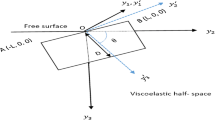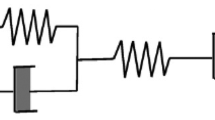Abstract
Seismically active regions are associated with fault systems and the movement of these faults influences the nature of stress accumulation/release in that region. For an in-depth analysis of the effect of such movement, we here developed a mathematical model by considering a surface breaking, inclined, finite strike-slip fault in the visco-elastic medium of Burger’s rheology. The caused deformation in the medium was then considered. Analytical expressions for displacements, stresses and strains were derived using Green’s function technique and Laplace transform. The variation of displacements, stresses and strains due to the locked fault was studied. These variations are graphically depicted for different inclinations of the fault with the free surface and for different fault movement velocities using MATLAB. Such studies may shed some light on the nature of stress and strain accumulation/release due to fault movement in Burger medium.
Access provided by Autonomous University of Puebla. Download conference paper PDF
Similar content being viewed by others
Keywords
1 Introduction
Earthquake is the shaking of the surface of the earth, resulting in the sudden release of energy in the earth’s lithosphere that creates seismic waves. Tectonic earthquakes occur when there is sufficiently stored elastic strain energy to drive fracture propagation along a fault plane. Recently, researchers have shown an increasing interest in the study of the nature of stress and strain accumulating/release due to fault movement in seismically active regions. While analyzing the dynamics of the earthquake process in that region, the study must be carried out not only during seismic periods (when an earthquake takes place) but also during the apparently static aseismic periods which involve slow, subsurface movements. These phenomena stimulated us to develop a mathematical model during aseismic periods to study the stress–strain accumulation/release due to seismic event.
A pioneering work on earthquake fault including static ground deformations in elastic media was started by Steketee (1958a, b). Okada (1986) presented an analytical expression for the surface displacements, strains and tilts due to inclined faults in a half-space for point and finite rectangular sources. Further, Okada (1992) calculated the internal displacements, strains and tilts for the same model as explained in 1986. In his book, Paul Segal (2010) has vividly described the elastic solution in continuum mechanics including the basics of volcano deformation and some advanced topics including visco-elasticity, elastic gravitational coupling and friction. Mondal et al. (2018) developed the effect of movement of an infinite, buried, inclined fault in visco-elastic half-space of Burger’s Rheology.
In most of these cases, the material is taken as elastic or visco-elastic half-space of Maxwell type or layered medium of standard linear solid representing the lithosphere-asthenosphere system. To the best of our knowledge, no theoretical model has been previously developed with finite fault in the visco-elastic half-space of Burger element type to represent earthquake faults. Hu (2016) suggested that Burger’s type visco-elastic material may be a suitable representation of the lithosphere-asthenosphere system in the seismically active region during aseismic periods. Also, Burger’s rheology has been used to describe post-seismic deformations as found in Pollitz (2003) and Hetland and Hager (2005). The Burger model which is the combination of Kelvin-Voiget and the Maxwell type material gives a comprehensive model for deriving time-dependent solutions for displacements, stresses and strains.
2 Model Description
In this paper, a theoretical model of a finite, strike-slip fault in the lithosphere-asthenosphere system in visco-elastic medium of Burger’s rheology was considered. The fault was taken to be inclined to the free surface, and the nature of displacements, stresses and strains was analyzed. Graphical representation of displacements, stresses and strains for different inclinations of the fault and various fault movement velocities was depicted from the analytical study.
A three dimensional theoretical model of a finite, locked, surface breaking, inclined, strike-slip fault of length 2L (L-finite), width D and inclination θ with the free surface was taken in the lithosphere-asthenosphere system. To represent this, we introduced a rectangular Cartesian co-ordinate system (y1, y2, y3) with plane free surface as y3 = 0, y3 axis points to the half-space, y1 is on the free surface parallel to the upper edge of the fault, y2 axis is perpendicular to y1–y3 plane. For convenience, we introduced a new co-ordinate system (y′1, y′2, y′3) as shown in Fig. 1 which is related to (y1, y2, y3) via the following relations;
To determine the displacements, stresses and strains, we considered the constitutive laws in the Burger medium which gave a relation between stress and strain including time derivatives. If the inertial forces are too small for a small deformation then the acceleration can be taken to be negligible and the body forces will not act in the system during our consideration. Under such situation, we considered the quasi-static equilibrium equations for the visco-elastic half-space. Along with the constitutive equation and stress equation of motion, suitable boundary conditions on stresses and initial conditions were taken. We started with a situation when the system is in an aseismic state. In this case, the displacements, stresses and strains are continuous throughout the system and their solutions can be found by using Laplace transform w.r.t time t to get a boundary value problem. Finally, inverse Laplace transform was considered to get the solutions for displacements, stresses and strains in the absence of any fault movement. It is to be noted that due to the sudden movement across the fault, the accumulated stress will be released at least to some extent and the fault becomes locked when the shear stress near the fault has been sufficiently released. For a comparatively short period of time during and after sudden fault movement, the inertial forces are not small and cannot be neglected. We leave out this short period of time during and immediately after sudden fault movement and consider the model after the restoration of the aseismic state which occurs when the seismic disturbances near the fault gradually disappear. We determined the displacements, stresses and strains during this second phase of aseismic state which is restored in the system after the sudden fault movement. The solutions of displacements, stresses and strains of this phase can be obtained using Laplace transform and Green’s function technique (Maruyama 1966; Rybicki 1971). Hence, the final solutions for displacements, stresses and strains can be obtained by taking the sum of displacements, stresses and strains before and after the fault movement.
3 Discussion
Some graphical representations of analytical expressions for displacements, stresses and strains against variation in depth, distances from the fault, inclinations and time were plotted which can depict the pattern of displacement, stress and strain accumulation/release due to fault movement in a Burger medium. Such representation may help develop an earthquake prediction program.
4 Conclusions
The explicit expressions for displacements, stresses and strains for a surface breaking, locked, inclined, finite strike-slip fault in visco-elastic half-space of Burger’s rheology have been obtained. These analytical solutions are useful in modeling the lithospheric-asthenospheric deformation associated with strike-slip faulting in the earth. Graphically, it was observed that the nature of displacements, stresses and strains were affected by the variation of inclination of the fault with free surface, velocity of the fault movements. The model was validated numerically and computed using suitable values of the model parameters. It was observed that the total displacement due to an infinite fault in a Burger medium (Mondal et al. 2018) is greater than that of a finite fault in the same medium. Permanent surface deformations which occur as a result of faulting can be measured by geodetic survey carried out before and after an earthquake. It was also observed that there are stress accumulation and release due to fault movement. The nature and the rate of stress accumulation/release near the fault may be used to study the behavior of the medium.
References
Hetland, E.A., Hager, B.H.: Postseismic and interseismic displacements near a strike-slip fault: a two dimensional theory for general linear viscoelastic rheologies. J. Geophys. Res. 110, B10401 (2005). https://doi.org/10.1029/2005JB003689
Hu, Y., Burgmann, R., Banerjee, P., Feng, L., Hill, E.M., Ito, T., Tabei, T., Wang, K.: Asthenosphere rheology inferred from observations of the 2012 Indian Ocean Earthquake. Nature 538, 368–372 (2016)
Maruyama, T.: On two dimensional dislocations in an infinite and semi-infinite medium. Bull. Earth-quake Res. Inst. Tokyo Univ. 44(part 3), 811–871 (1966)
Mondal, D., Sarkar (Mondal), S., Sen. S.: Effect of movement across a long, inclined, buried, creeping, strike-slip fault in the visco-elastic medium of burger’s rheology. J. Eng. Appl. Sci. 14(3), 965–974 (2018)
Okada, Y.: Surface deformation due to shear and tensile fault in a half-space. Bull. Seismol. Soc. Am. 75(4), 1135–1154 (1986)
Okada, Y.: Internal deformation due to shear and tensile fault in a half-space. Bull. Seismol. Soc. Am. 82(2), 1018–1040 (1992)
Pollitz, F.F.: Transient rheology of the uppermost mantle beneath the Mojave desert, California. Earth Planet. Sci. Lett. 215, 89–104 (2003)
Rybicki, K.: The elastic residual field of a very long strike-slip fault in the presence of a discontinuity. Bull. Seis. Soc. Am. 61, 79–92 (1971)
Segal, P.: Earthquake and Volcano Deformation. Princeton University Press (2010)
Stekeetee, J.A.: On Volterra’s dislocations in a semi-infinite medium. Can. J. Phys. 36, 192–205 (1958a)
Stekeetee, J.A.: Some geophysical applications of the theory of dislocations. Can. J. Phys. 36, 1168–1198 (1958b)
Author information
Authors and Affiliations
Editor information
Editors and Affiliations
Rights and permissions
Copyright information
© 2022 The Author(s), under exclusive license to Springer Nature Switzerland AG
About this paper
Cite this paper
Kundu, P., Mondal, S.S. (2022). Effect of the Movement Across a Surface Breaking, Inclined, Locked, Finite Strike-Slip Fault in Visco-elastic Medium of Burger’s Rheology. In: Meghraoui, M., et al. Advances in Geophysics, Tectonics and Petroleum Geosciences. CAJG 2019. Advances in Science, Technology & Innovation. Springer, Cham. https://doi.org/10.1007/978-3-030-73026-0_118
Download citation
DOI: https://doi.org/10.1007/978-3-030-73026-0_118
Published:
Publisher Name: Springer, Cham
Print ISBN: 978-3-030-73025-3
Online ISBN: 978-3-030-73026-0
eBook Packages: Earth and Environmental ScienceEarth and Environmental Science (R0)





